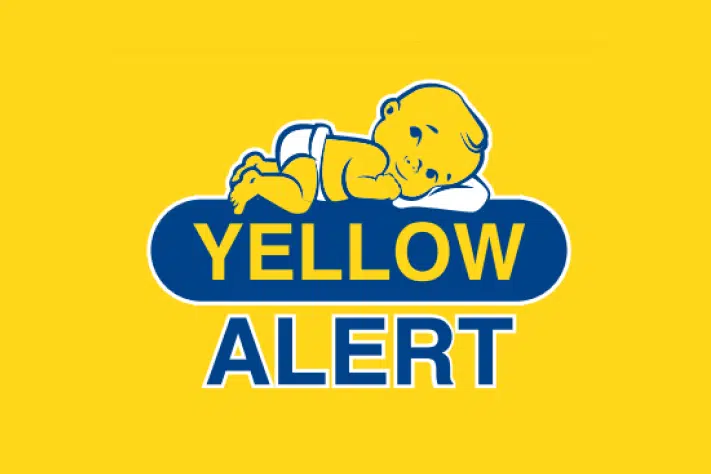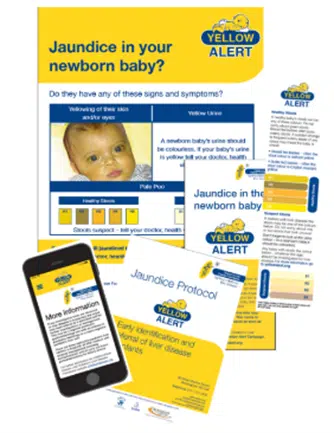15th January 2024

In support of Love Your Liver awareness month, we are delighted to share this Voices blog by Joanne Taylor, Information and Awareness Lead at the Children’s Liver Disease Foundation (CLDF). Joanne shares the importance of health visitors being aware of the CLDF’s Yellow Alert campaign.
As we move into January and start a new year, the team at Children’s Liver Disease Foundation are turning their attention to Love Your Liver Awareness month. This gives us a great opportunity to talk about neonatal jaundice, our Yellow Alert campaign, and some important developments over the last year.
Jaundice is very common in newborn babies. Around 60% of full-term babies and 80% of premature babies develop jaundice in the first week of life. Jaundice will clear in most babies, but if it persists beyond 14 days (21 day in a pre-term baby) it can be a sign of liver disease.
We know that health visitors have a key role to play in spotting prolonged jaundice and the early signs of liver disease. They ensure that infants are identified and referred promptly to specialist centres for investigation and treatment. This is so important because liver disease in children is rare, but it can be life threatening.
One of the most common forms of childhood liver disease is biliary atresia. This is where bile ducts form abnormally, or they become inflamed or obstructed. The resulting damage reduces the flow of bile, and this leads to cirrhosis of the liver. If it is diagnosed early, a corrective Kasai procedure can be performed to re-establish bile flow. In order to give the Kasai the best chance of success, it should ideally take place before a baby is eight weeks old. The procedure is not a permanent solution in most children, but it will delay the need for a liver transplant.
Yellow Alert campaign
Yellow Alert is our national campaign that promotes the early identification of liver disease in infants. We have developed a collection of free resources to help healthcare professionals, and particularly health visitors, to recognise prolonged jaundice and liver disease in the community.
There are some key messages in our Yellow Alert campaign:
- Prolonged jaundice (yellowing of the skin and the whites of the eyes) can be a sign of liver disease. It is defined as jaundice persisting beyond two weeks of age in a full-term baby and three weeks in a pre-term baby.
- Persistently pale coloured stools may indicate liver disease. Healthy coloured stools can be described as ‘England mustard’ yellow in bottle-fed babies and ‘daffodil’ yellow in breast-fed babies.
- A baby’s urine should be colourless. Urine which is anything other than colourless could be a possible sign of liver disease.
- All babies with prolonged jaundice or abnormally coloured stools and/or urine must urgently be referred for a special blood test called a split bilirubin blood test to rule out potentially life-threatening liver disease.
- If the split bilirubin test highlights that the conjugated fraction of bilirubin is greater than 20%, the baby should be referred to a paediatrician or specialist centre for further investigation.
Our Yellow Alert resources include a stool chart, jaundice protocol and leaflets for parents and families. We have also developed an app to give healthcare professionals the information they need in the quickest, most accessible way possible. Yellow Alert resources can be viewed online, or they can be ordered in hard copy using our order form. CLDF staff are also very happy to give talks and attend meetings to help educate health visitors and students about childhood liver disease.
Recognition of jaundice in different skin tones
The last year has also seen some important developments regarding neonatal jaundice. NICE guidance has been updated and now states that jaundice can be harder to see in darker skin tones. This is a positive step forward. Reports have also been produced by the NHS Race and Health Observatory and Health Services Safety Investigations Body (HSSIB). They both look at neonatal jaundice and there is a particular focus on jaundice recognition in different skin tones.
Here at CLDF, we are happy to see that this issue is being discussed so widely. Healthcare professionals often tell us that they are concerned about detecting jaundice in Black, Asian and minority ethnic babies. We are delighted that the Institute of Health Visiting is working with the NHS Race and Health Observatory to address this gap – look out for the iHV Insights webinar on this topic on 25 April and bespoke resources for health visitors later in the year.
At CLDF, we support health visitors by promoting the use of stool and urine colour as more consistent indicators of prolonged jaundice and liver disease. It is also a useful tool to use in babies with different skin tones. Stool charts have the added advantage of being portable and health visitors often tell us that they like to have a stool chart with them when they visit families. The stool charts can also be given to new parents to encourage them to check stools and to seek further advice if needed (these can be ordered from CLDF here).
As a new year begins, we will continue to work hard at Children’s Liver Disease Foundation to promote our Yellow Alert campaign. We want to make sure that all health visitors have the tools and information they need to help diagnose liver disease as early as possible. You all have a vital role to play, so we look forward to supporting you in 2024!
Joanne Taylor, Information and Awareness Lead, Children’s Liver Disease Foundation
[email protected]
https://childliverdisease.org/
Children’s Liver Disease Foundation (CLDF) is the only UK charity dedicated to fighting all childhood liver diseases
References
- Review of neonatal assessment and practice in black, asian, and minority ethnic newborns NHS Race & Health Observatory, 2023
- Jaundice in newborn babies under 28 days National Institute for Health and Care Excellence, 2023
- Detection of jaundice in newborn babies Health Services Safety Investigations Body, 2023
*The iHV has adopted a gender-additive approach to the language we use in policies, resources, projects, and events. A gender additive approach means using gender neutral language alongside the language of womanhood, to ensure that everyone is represented and included. Please note that this publication uses gendered terms when referencing research which is gender specific.





